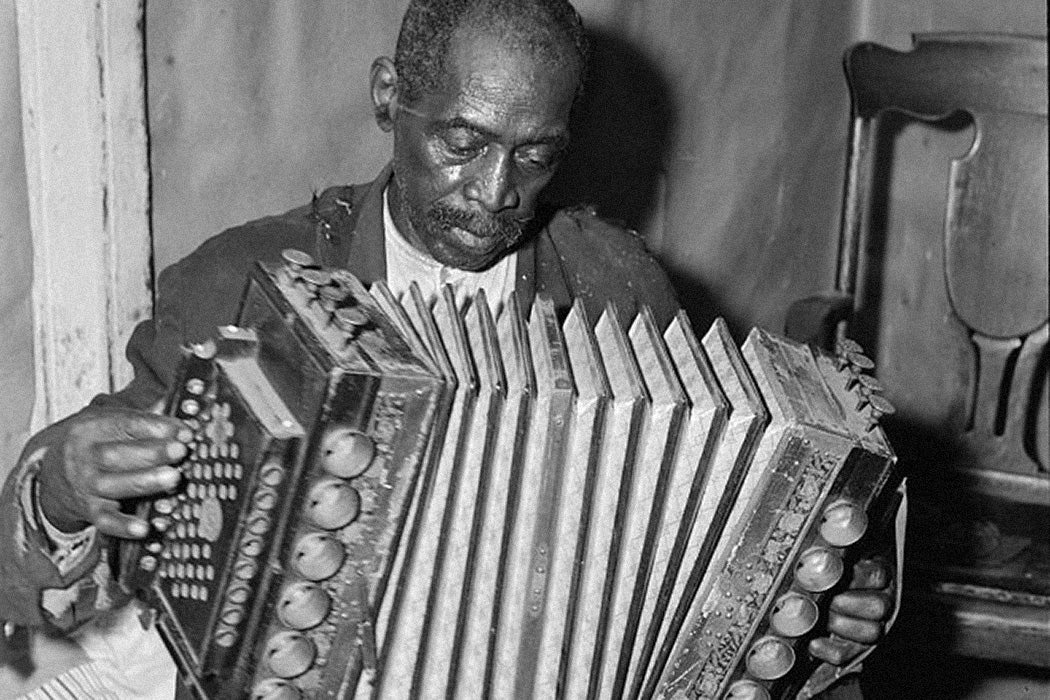The accordion had an image problem. It was the 1960s, and it just wasn’t cool. As historian Marion S. Jacobson explains, accordion players faced “a latent lack of excitement about their instrument, and, more alarmingly, the decline of the values it represented,” from a certain part of the population (white, middle-class). As one player noted, in the 1960s and ’70s, it “was the most unhip instrument you could be playing.” But this “unhip” instrument had history in some surprising places. As historian Jared M. Snyder writes, “the fact that it was adopted by [B]lack musicians contributes insight into a neglected strand of African American music history.”
Manufacturers tried to respond to the “uncool” claims by making new styles like the Tiger Combo “Rockordion” model, which featured bright colors and an extra set of reeds that allowed it to be used to play popular hits of the time. The accordion used to be a way to “introduce the public to classical music,” writes Jacobson, and redirect from “its interest in folk music.” But in shifting it away from its folk roots, marketers were also glossing over how big of a role the instrument played in Black music. As Snyder points out, it was only in the 1970s that researchers began to examine in earnest the “immense popularity of the accordion in Africa and throughout the black diaspora.”
The word accordion conjures up a specific image, writes Snyder, “a keyboard on one side of the bellows and a set of bass buttons on the other side,” and with this image, a type of music might come to mind as well—likely not blues or gospel. But there’s another type of accordion, the button accordion, with buttons on either side of the bellows. This was the type that drew in Black musicians. The button accordion was introduced in America in 1840, and was used by blackface minstrel groups as early as 1843. Their traveling spread the instrument’s popularity while also spreading the idea that their performances represented “true plantation life,” Synder writes.
By 1846, stores began carrying and advertising the instrument. One Louisiana plantation owner even listed an accordion as “supplies for the plantation” in one of his retail orders. Though Snyder acknowledges that these incidents don’t shed light on just how many Black musicians played the instrument during this period, there are accounts from formerly enslaved musicians and their descendants about its importance. Blues performers Big Joe Williams and K.C. Douglas both noted that their grandfathers played the accordion, for instance. And one musician, ninety-two-year-old Clarence Tross from West Virginia, told a researcher in 1975 that “it was mostly the colored man playing the accordion.”
The accordion was also popular in Black churches as the violin was seen as sinful, notes Snyder. According to an 1892 report in the Boston Transcript, “it involves neither deadly sin nor any spiritual risk whatever to play the accordeon [sic].” Commercially, the recording industry was beginning to understand its appeal by the turn of the century as well. Accordionist Walter “Pat” Rhodes was one of the first Mississippi Delta blues musicians to record, Snyder writes. His 1927 recording for Columbia Records sold well in his home area, but failed to make a mark outside of the Delta.
Weekly Newsletter
Perhaps the most notable name among button accordion players is that of Huddie “Leadbelly” Ledbetter. In fact, after the relative failure of Rhodes’s recording, there were “no other commercial recordings on the button accordion” until Leadbelly’s releases in the 1940s, Snyder writes. Referring to the diatonic button accordion as a “windjammer” in interviews, Leadbelly “described fiddles and accordions as part of the standard instrumentation for the dance bands of his youth.” He’d later play both accordion and guitar in some of those ensembles. He actively played the windjammer from 1901 to 1917 until the folk music and accompanying dances began to fall out of favor with Black listeners, replaced by songs featuring piano and guitar.
It may not have had the longevity of the guitar or piano, but the accordion held a special place in Black music for many years. As Snyder sums up, “No tradition that produced excellent work from a master musician of Leadbelly’s caliber is, in final analysis, unimportant.”
Support JSTOR Daily! Join our membership program on Patreon today.







